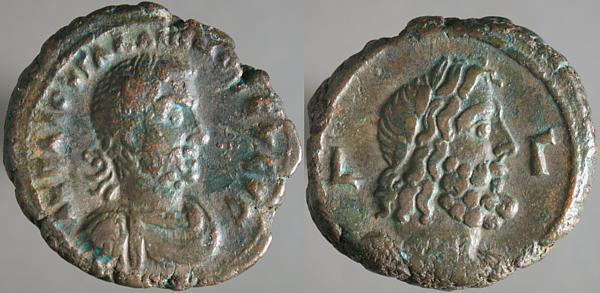Saturday, July 24, 2004
meta, meta, meta
Got a nice mention over at Reflections in d minor and there learned about Laudator Temporis Acti, which is added to the sidebar.
On the downside, just got outbid on a nice Valerian sestertius, but I did bid as high as I felt like paying, so it's just a case of someone else wanting it more.
On the downside, just got outbid on a nice Valerian sestertius, but I did bid as high as I felt like paying, so it's just a case of someone else wanting it more.
Silvered Æ antoninianus, Gallienus, Antioch, Göbl 1655b
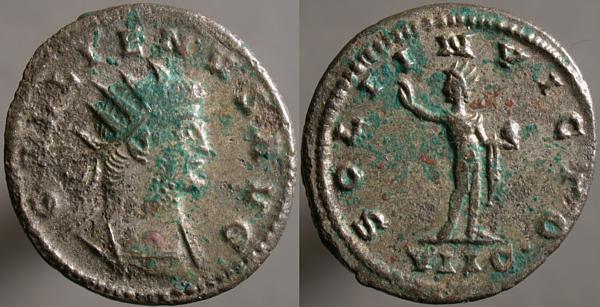
GALLIENVS AVG, Radiate cuirassed bust right | SOLI INVICTO, Radiate-crowned Sol standing facing, nude but for chlamys, head left, holding globe right and raising hand left. VIIC· in exergue.
Minted sometime between January and September 266, this coin features Sol Invictus, the invinceable Sun, whom the Romans modeled on the Greek sun-god Helios, and subsequently projected onto the Persian god Mithras, chief god of Mithraism and a favorite of Emperors and soldiers alike. It's Sol's radiate crown, symbolizing the rays of the sun, that the Emperor wears on so many of the coins I've posted here.
Friday, July 23, 2004
Æ31, Tarsus in Cilicia, Valerian, SNG Copenhagen 408
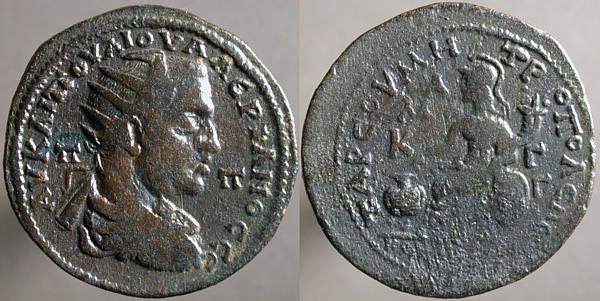
ΑV ΚΑΙ ΠΟV ΛΙ ΟVΑΛΕΡΙΑΝΟC CΕ, Radiate draped cuirassed bust right. Π before and behind | ΤΑΡC_ΟV ΜΗΤΡ_ΟΠΟΛ, Athena, representing the Koinoboulion (Assembly) of Tarsus, seated left, dropping ballot into urn, resting arm on shield, and holding cornucopiae; Α Μ Κ in left field, Γ Γ in right field. ΚΟΙ[ΝΟΒΟVΛΙΟΝ / ΕΛΕVΘΕ] in exergue.
Back in March I posted a coin with this reverse, minted for Gallienus. During the joint reign of Valerian and Gallienus most imperial coins, and many provincials, were minted for both. Once Valerian was taken captive by the Sassanian Persian king Shapur, mention of him was not made.
Thursday, July 22, 2004
Billon antoninianus, Gallienus, Mediolanum, Göbl 996n
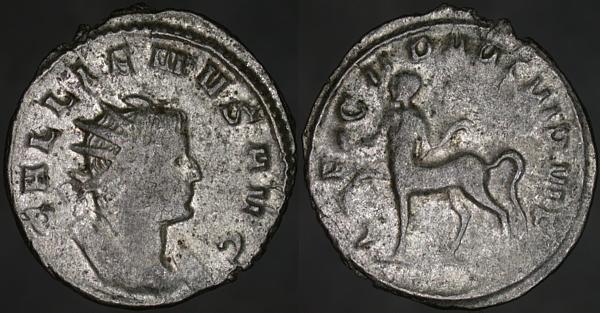
GALLIENVS AVG, Radiate cuirassed bust right | LEG II PART VI P VI F, Centaur standing left, one foreleg raised, holding globe left, cloak flying right.
As Monday's coin did, this too represents one of my collecting weaknesses: the Legionary series of Gallienus, which honors dutifulness and fidelity of the various legions serving Gallienus against various European usurpers, and which features the badges of those legions.
Back in November of last year, I posted this coin, which, like today's coin, honors Legio II Parthica for the sixth pietas et fidelitas. The reverse design there, a centaur leaping right, brandishing club, was used on this legion's late VI P VI F coins, and for all their VII P VII F coins.
The design on today's reverse, a centaur standing left, one foreleg raised, holding globe left, cloak flying right, was used on all their V P V F coins, and their early VI P VI F coins.
I've no idea if the legion actually changed their emblem at this time, or if it's just artistic license.
Wednesday, July 21, 2004
AR denarius, Tiberius, Lugdunum, 14-37 CE, RIC 30
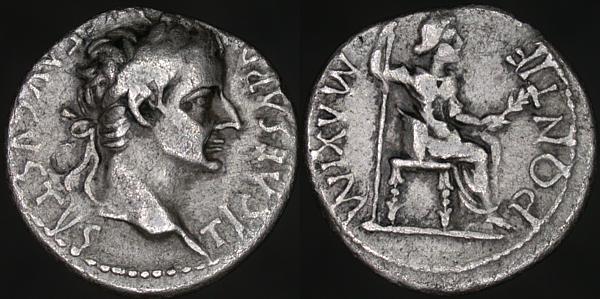
TI CAESAR DIVI F AVGVSTVS, Laureate head right | PONTIF MAXIM, Livia? seated right, holding scepter left and branch right.
Some information on Lugdunum, and Tiberius. I'm going somewhere else today, though.
This coin, like the "widow's mite," represents a high point in the marketing of ancient coins. In his 23 years as emperor, Tiberius used only two basic designs for the denarius: a rare series featuring himself in triumph, probably not minted beyond the third year of his reign, and this design, in minor variations, minted in the millions throughout his reign.
A drug on the market at one time, demand has continuously exceeded supply since some bright dealer began promoting it as the Tribute Penny.
Not everyone's buying the story, but plenty are selling it.
Which isn't a bad thing. Some of those coins will wind up making people interested enough in ancient coins that they'll start to collect.
Tuesday, July 20, 2004
Æ tetradrachm, Alexandria, Gallienus, Emmett 3823(9 - ENATOV)
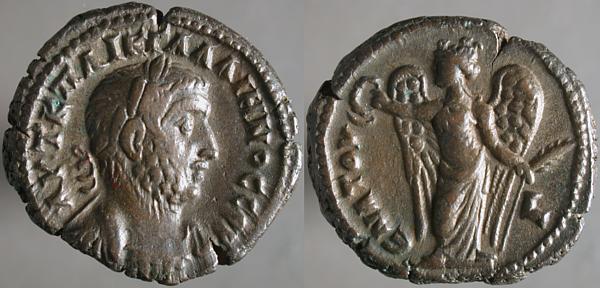
ΑVΤ Κ Π ΛΙΚΓΑΛΛΙΗΝΟC CΕΒ,Laureate cuirassed bust right | L ΕΝΑΤΟV, Nike standing facing, head left, wings spread, holding wreath left and palm right. Regnal year spelled out left.
Minted in 261-262 CE, this coin has a reverse showing Nike, the Greek prototype for the Roman Victoria.
By the Alexandrian calendar, in use in Roman Egypt, this was the ninth year of Gallienus's reign. Alexandrian coins normally bore the emperor's regnal date, expressed in Greek numerals.
The number nine, however, was represented by Θ, theta, the first letter in Θανατος, Thanatos, Death, and unlucky in that culture as 13 is in ours. Rather than take a chance, most Alexandrian coins of year nine, for any emperor, spell out the word for nine, ΕΝΑΤΟV, which apparently wasn't unlucky in itself.
Monday, July 19, 2004
"We need your help"
Further signs of the apocalypse
The Frogs the musical
Æ denarius, Gallienus, Rome, Göbl 669t
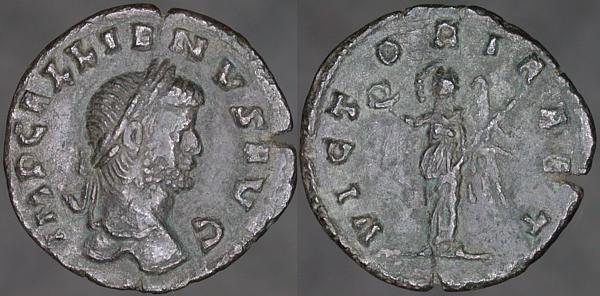
IMP GALLIENVS AVG, Laureate head right | VICTORIA AET, Victory standing left holding wreath left and palm right.
I'm not proud of it, but I have a weakness for the denarii of this reign: they're not pretty, but they are hard to find. While they continued to be minted, in small numbers, through most of the reign, there doesn't seem to have been much need for them, much place for them in the economy.
What did they need them for, in such small numbers?
